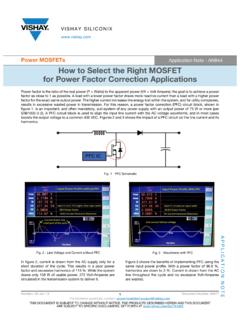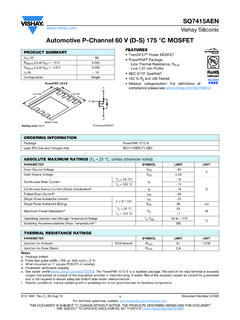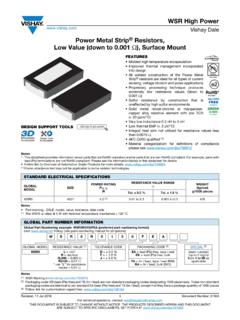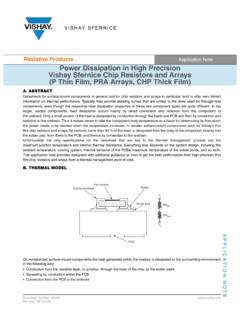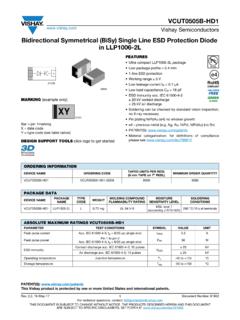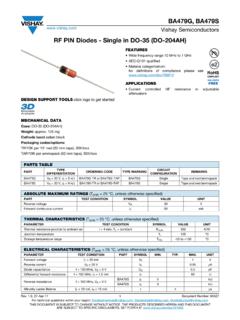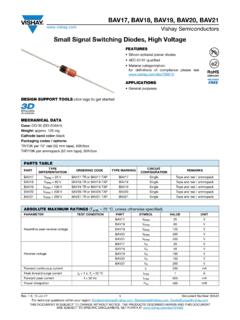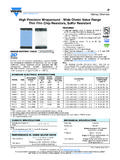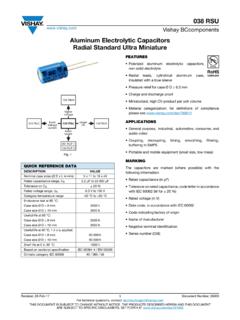Transcription of IGBT/MOSFET Gate Drive Optocoupler - Vishay …
1 Vishay SEMICONDUCTORSO ptocouplers and Solid-State RelaysApplication Note 91 IGBT/MOSFET gate Drive OptocouplerAPPLICATION NOTE Rev. , 24-Oct-111 Document Number: 81227 For technical questions, contact: DOCUMENT IS SUBJECT TO CHANGE WITHOUT NOTICE. THE PRODUCTS DESCRIBED HEREIN AND THIS DOCUMENTARE SUBJECT TO SPECIFIC DISCLAIMERS, SET FORTH AT TO IGBTThe Insulated gate Bipolar transistor ( igbt ) is a crossbetween a MOSFET (metal oxide semiconductor field effecttransistor) and a BJT (bipolar junction transistor) since itcombines the positive aspects of mosfets and igbt has the fast switching capability of the MOSFETand is capable of handling the high current values typical ofa BJT. In addition, IGBTs have a lower on-state voltage dropand are capable of blocking higher igbt , as a first approximation, can be modeled as aPNP transistor driven by a power MOSFET, as shown infigure 1.
2 Fig. 1 - Simplified igbt Equivalent CircuitFigure 2 shows the most common symbols used for igbt . Fig. 2 - igbt SymbolsThe equivalent circuit for the input of igbt is the same as aMOSFET and is purely capacitive. This allows the use of avoltage Drive , which means that it is possible to have a lesscomplex circuit with lower power consumption compared toa BJT. IGBTs are used for high current, high voltageapplications when switching speed is important (table 1). igbt SWITCHING BEHAVIOROne of the important performance features of any switchingdevice is the switching (turn-on and turn-off) characteristic,since significant power losses are incurred during theseswitching driving inductive loads, the device under goes higherstress. Hence, it makes sense to study the turn-on andturn-of time of the IGBT/MOSFET when driving igbt s internal input capacitance (CGE) and Millercapacitance (CGC) impacts the igbt turn-on behavior.
3 Butthe CGC effect is very small and negligible. Figure 3illustrates the parasitic igbt capacitances. Fig. 3 - igbt Parasitic CapacitancesCEGCEGCEGTABLE 1- IGBTS VS. MOSFETSIGBTSPOWER MOSFETSTYPEVOLTAGE DRIVENVOLTAGE DRIVENC urrent density per voltage dropVery high, small trade-off with switching speedHigh at low voltage low at high voltageSwitchung lossesLow to mediumVery lowCEGCGCCGECCECGC = feedback or MillercapacitanceCGE = input capacitanceCCE = output capacitanceIGBT/MOSFET gate Drive OptocouplerAPPLICATION NOTEA pplication Note Semiconductors Rev. , 24-Oct-112 Document Number: 81227 For technical questions, contact: DOCUMENT IS SUBJECT TO CHANGE WITHOUT NOTICE. THE PRODUCTS DESCRIBED HEREIN AND THIS DOCUMENTARE SUBJECT TO SPECIFIC DISCLAIMERS, SET FORTH AT datasheets specify the voltage-dependent low-signalcapacitance of igbt / mosfets in the off-state (table 2).
4 The turn-on behavior of the igbt is identical to the powerMOSFET, since the igbt acts as a MOSFET during most ofthe turn-on interval. When a gate signal is applied, the gateemitter voltage of the igbt rises from zero to VGE(TH), asshown in figure 4. This voltage rise is due to the gateresistance (Rgate) and the CGE. Fig. 4 - igbt Turn-On SequenceThe turn-on time is a function of the output impedance of thedrive circuit and the applied gate voltage. Hence, it ispossible to control the turn-on speed of the device bychoosing an appropriate value of gate resistance (Rgate).In other words, by varying the Rgate it is possible to vary thetime constant of the parasitic net equal to Rgate x (CGE+CCG)and then dV/dt. Therefore, the Rgate value strongly impactsthe power losses, since its variation also affects the dV/dtslopes as illustrated in figure 5.
5 Fig. 5 - Rgate Effect on dV/dtThe turn-off behavior of the igbt , as shown in figure 6, hasa dual characteristic of both power MOSFET and BJTdevices. Fig. 6 - igbt Turn-Off SequenceAt turn-off, the gate voltage begins to decrease until itreaches the value when the Miller effect occurs; during thistime the VCE voltage increases changing the outputcharacteristics with constant , the Miller effect and the VGE voltage remain constantbecause of modulation of the collector gate capacitance,which is due to VCE voltage rapidly increasing to itsmaximum value. During this time, the collector currentbegins to fall quickly, and continues with a tail which is dueto recombination of minority carriers in the faster (and first) part of the IC current is due to theturn-off of the MOSFET portion of the igbt structure.
6 TheIC-tail, which is due to the turn-off the BJT portion of the igbt structure, causes the major part of the switching losses. TABLE 2 - igbt AND MOSFET CAPACITANCECAPACITANCEIGBTSPOWER MOSFETSI nputCiss = CGE + CGCCiss = CGS + CGDR everse transferCrss = CGCCrss = CGDO utputCoss = CGC + CCECoss = CGD + CDSIC = 0 AICVCEVCE(sat) I(t)V(t)tv-fallti-riseVGEVGE(TH)QCGQGEVG E = 0 V19892 CECCGCGER gatedV/dtICIC = CCG x dV/dtICIC-tailtfalltriseQGEQCGVGEVGE/TH) V(t)I(t)VGE = 0 VVCEIC = 0 AVCEIGBT/MOSFET gate Drive OptocouplerAPPLICATION NOTEA pplication Note Semiconductors Rev. , 24-Oct-113 Document Number: 81227 For technical questions, contact: DOCUMENT IS SUBJECT TO CHANGE WITHOUT NOTICE. THE PRODUCTS DESCRIBED HEREIN AND THIS DOCUMENTARE SUBJECT TO SPECIFIC DISCLAIMERS, SET FORTH AT POWER DISSIPATIONThe maximum switching frequency of an igbt is limited byits power dissipation during switching.
7 The junctiontemperature (Tj) during normal operation depends on theamount of power dissipated from the device and theefficiency of the heat sink.(1)To select a heat sink, which keeps the junction temperatureat or below a given temperature, the following equation canbe used:(2)Where: SA= heat sink to ambient thermal resistance JC= junction-to-case thermal resistance CS= case to heat sink thermal resistancePtot= total power dissipationTC= case temperatureWhen an efficient heat sink is used, TC will be lowered. Thismeans that the difference between junction-to-casetemperature will be greater. Hence, a higher amount ofpower can be is the maximum continuous power dissipated by thedevice for a given case temperature. The maximum powerdissipation is related to permissible case temperature riseand junction-to-case thermal resistance.
8 (3)The main factor is to determine the Ptot of igbt is theVCE(SAT) level, which is dependant on junction temperature,collector current ,and gate emitter voltage.(4) igbt SWITCHING POWER LOSSESWhen turning an igbt on or off, the level of VGE and Rgateaffects the switching losses of the device. The effect ofincreasing VGE or reducing Rgate is to reduce the delay time,rise time, and fall times of the device and hence to reducethe switching losses. Reducing the level of VGE or increasingRgate results in increased switching losses but can reduceelectromagnetic interference (EMI). Other factors affectingthe switching losses include the anti parallel diode (FWD),circuit inductance, snubbers, device junction temperature,operating voltage, and current. The use of FWD is illustratedin figure 7.
9 Fig. 7 - FWD is used with igbt to Adjust Switching SpeedThe reverse-recovery and turn-on characteristics of theFWD can be controlled to a certain extent by adjusting thespeed of the igbt . In the event of a diode becoming toosnappy in an application, the igbt turn-on can be sloweddown, hence reducing the value of dV/dt applied to thediode and so reducing the diode losses. However, this is atthe expense of increasing the igbt losses. An alternativemethod of reducing the FWD losses in a bridgeconfiguration is to turn on the igbt with a reduced VGE. Thislimits the peak reverse recovery current, Irr, of the FWD inthe opposite side of the arm, according to the IGBTs'forward output illustrated in figures 4 and 6, there is a finite time interval,during both turn-on and turn-off of the igbt , where finiteVCE and IC coexist.
10 CISS, COSS, and CRSS affect the turn-onand turn-off times as well as turn-on and turn-off delay timesand are responsible for some energy igbt power losses during both turn-on and turn-offcan be computed as follows:(5)(6)(7)(8)(9)JC tot C jP T T +=CSJC tot SA P T =JC C J tot T T P =) ( ) ( sat CE ave CE tot V I P =CERgateFWD) ( ) ( off SW on SW SW E E E +==ESW tIVCCE)(t)(dt =dtItVECCESW)( i-rise dttIVCCE)(+ v-fallon)(onSWE=)(CCEtIV 21i-riset)(+v-fall=EoffSW)( dttVCE)( v-rise dttV)(+ i-fallCECICIIGBT/MOSFET gate Drive OptocouplerAPPLICATION NOTEA pplication Note Semiconductors Rev. , 24-Oct-114 Document Number: 81227 For technical questions, contact: DOCUMENT IS SUBJECT TO CHANGE WITHOUT NOTICE. THE PRODUCTS DESCRIBED HEREIN AND THIS DOCUMENTARE SUBJECT TO SPECIFIC DISCLAIMERS, SET FORTH AT (10)(11)Where:ESW= switching energy losston= ti-rise + tv-fall = turn-on timetoff= tv-rise + ti-fall = turn-off time(12)Where:PSW= switching power lossfSW= switching frequencyPower dissipated during turn-on is calculated as follows: (13)Figure 6 indicates that the power dissipated during turn-offis due to two first such factor is the speed at which the collectorvoltage reaches its maximum value.
